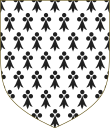
The Duchy of Brittany was a medieval feudal state that existed between approximately 939 and 1547. Its territory covered the northwestern peninsula of Europe, bordered by the Atlantic Ocean to the west, and the English Channel to the north. It was also less definitively bordered by the river Loire to the south, and Normandy, and other French provinces, to the east. The Duchy was established after the expulsion of Viking armies from the region around 939. The Duchy, in the 10th and 11th centuries, was politically unstable, with the dukes holding only limited power outside their own personal lands. The Duchy had mixed relationships with the neighbouring Duchy of Normandy, sometimes allying itself with Normandy, and at other times, such as the Breton–Norman War, entering into open conflict.
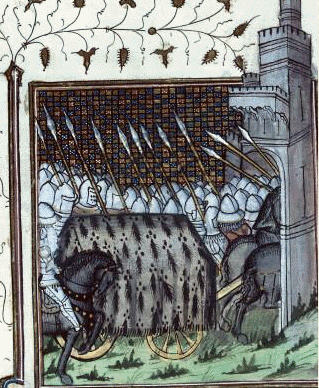
John III the Good was Duke of Brittany, from 1312 to his death and 5th Earl of Richmond from 1334 to his death. He was the son of Arthur II, Duke of Brittany, and his first wife Marie, Viscountess of Limoges. John was strongly opposed to his father's second marriage to Yolande and attempted to contest its legality.
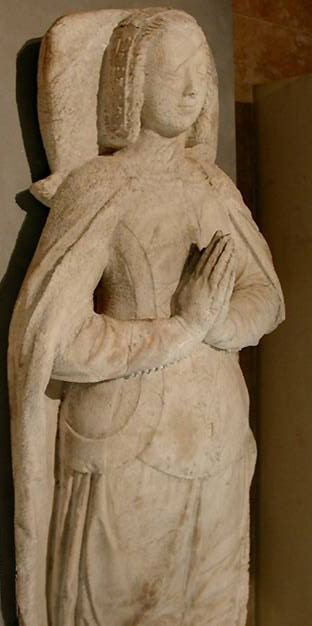
Joan of Penthièvre reigned as Duchess of Brittany together with her husband, Charles of Blois, between 1341 and 1364. Her ducal claims were contested by the House of Montfort, which prevailed only after an extensive civil war, the War of the Breton Succession. After the war, Joan remained titular Duchess of Brittany to her death. She was Countess of Penthièvre in her own right throughout her life.
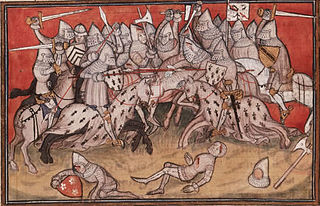
The War of the Breton Succession was a conflict between the Counts of Blois and the Montforts of Brittany for control of the Duchy of Brittany, then a fief of the Kingdom of France. It was fought between 1341 and 12 April 1365. It is also known as the War of the Two Joans due to the involvement of two rival duchesses of that name.

John of Montfort, sometimes known as John IV of Brittany, and 6th Earl of Richmond from 1341 to his death. He was the son of Arthur II, Duke of Brittany and his second wife, Yolande of Dreux. He contested the inheritance of the Duchy of Brittany with his niece Joan of Penthièvre, which led to the War of the Breton Succession, which in turn evolved into being part of the Hundred Years' War between England and France. John's patron in his quest was King Edward III of England. He died in 1345, 19 years before the end of the war, and the victory of his son John IV over Joan of Penthièvre and her husband, Charles of Blois.

John IV the Conqueror KG, was Duke of Brittany and Count of Montfort from 1345 until his death and 7th Earl of Richmond from 1372 until his death.
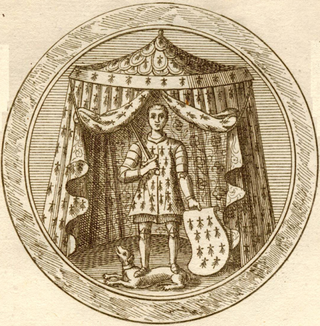
John V, sometimes numbered as VI, bynamed John the Wise, was Duke of Brittany and Count of Montfort from 1399 to his death. His rule coincided with the height of the Hundred Years' War between England and France. John's reversals in that conflict, as well as in other internal struggles in France, served to strengthen his duchy and to maintain its independence.
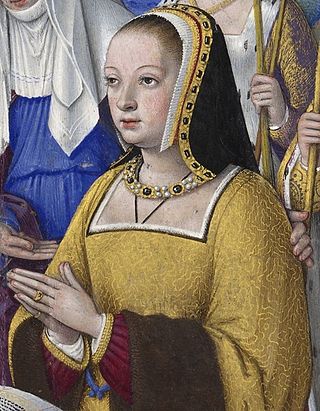
Anne of Brittany was reigning Duchess of Brittany from 1488 until her death, and Queen of France from 1491 to 1498 and from 1499 to her death. She was the only woman to have been queen consort of France twice. During the Italian Wars, Anne also became Queen of Naples, from 1501 to 1504, and Duchess of Milan, in 1499–1500 and from 1500 to 1512.

The now-extinct title of Earl of Richmond was created many times in the Peerage of England. The earldom of Richmond was initially held by various Breton nobles; sometimes the holder was the Breton duke himself, including one member of the cadet branch of the French Capetian dynasty. The historical ties between the Duchy of Brittany and this English earldom were maintained ceremonially by the Breton dukes even after England ceased to recognize the Breton dukes as earls of England and those dukes rendered homage to the King of France, rather than the English crown. It was then held either by members of the English royal families of Plantagenet and Tudor, or English nobles closely associated with the English crown. It was eventually merged into the English crown during the reign of Henry VII of England and has been recreated as a Dukedom.

Joan of Flanders was duchess of Brittany by her marriage to John of Montfort. Much of her life was taken up in defense of the rights of her husband and, later, son to the duchy, which was challenged by the House of Blois during the War of the Breton Succession. Known for her fiery personality, Joan led Montfort's cause after her husband had been captured by Philip VI of France, and began the fight back. There, she displayed considerable skill as a military leader and gained the respect of her people.

The House of Rohan is a Breton family of viscounts, later dukes and princes in the French nobility, coming from the locality of Rohan in Brittany. Their line descends from the viscounts of Porhoët and is said to trace back to the legendary Conan Meriadoc. Through the Porhoët family, the Rohans are related to the Dukes of Brittany, with whom the family intermingled again after its inception. During the Middle Ages, it was one of the most powerful families in the Duchy of Brittany. The Rohans developed ties with the French and English royal houses as well, and they played an important role in French and European history.
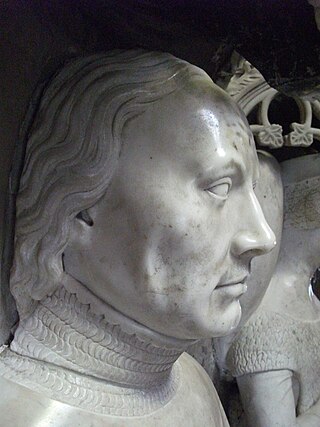
Olivier V de Clisson, nicknamed "The Butcher", was a Breton soldier, the son of Olivier IV de Clisson. His father had been put to death by the French in 1343 on the suspicion of having willingly given up the city of Vannes to the English.
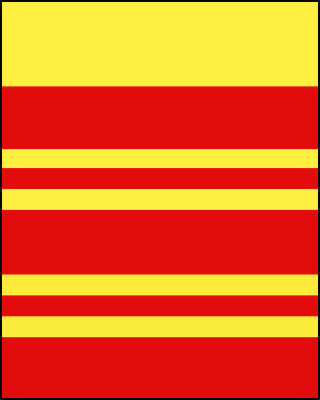
In the 11th and 12th centuries the Countship of Penthièvre in Brittany belonged to a branch of the sovereign House of Brittany. It initially belonged to the House of Rennes. Alan III, Duke of Brittany, gave it to his brother Eudes in 1035, and his descendants formed a cadet branch of the ducal house.

The House of Dreux was a cadet branch of the Capetian dynasty. It was founded by Robert I, Count of Dreux, a son of Louis VI of France, who was given the County of Dreux as his appanage.
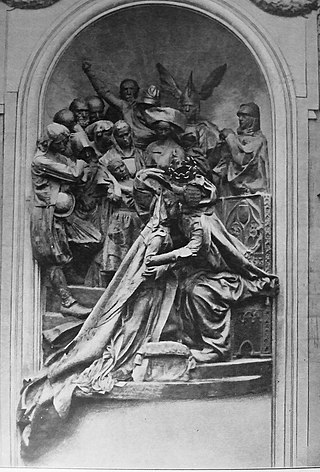
The union of the Duchy of Brittany with the Crown of France was the culmination of a political process begun at the end of the 15th century in the wake of the Mad War. It resulted in the Edict of Union of 13 August 1532 and the incorporation of the duchy into the Crown lands of France, a critical step in the formation of modern-day France.
The first treaty of Guérande, signed on 12 April 1365, ended the Breton War of Succession.
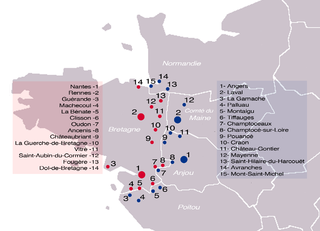
The French–Breton War lasted from 1487 to 1491. The cause of this war was the approaching death of the Breton Duke Francis II of Brittany, who had no clear successor. If not resolved, this meant a resumption of issues from a previous War of the Breton Succession (1341–1364), which had rival claimants allying with England or France, resulting in an ambiguous peace treaty that failed to prevent future succession disputes.
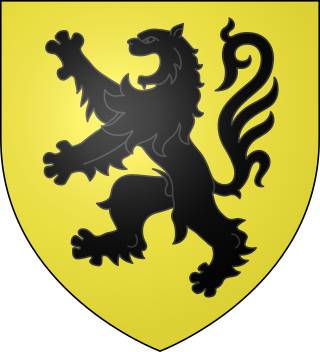
Herve VII of Léon was a Breton lord, son of Herve VI, Lord of Léon and his wife Joanna of Montmorency. Also known as Herve. He succeeded his father as Lord of Léon in 1337. He was also Lord of Noyon-sur-Andelle. The Lords of Léon were a junior branch of the Viscounts of Léon which was founded by Harvey I, second son of Guihomar IV, Viscount of Léon. Herve VII won fame during the War of the Breton Succession.

John I, was Count of Penthièvre and Viscount of Limoges from 1364 to 1404, and the Penthièvre claimant to the Duchy of Brittany.
